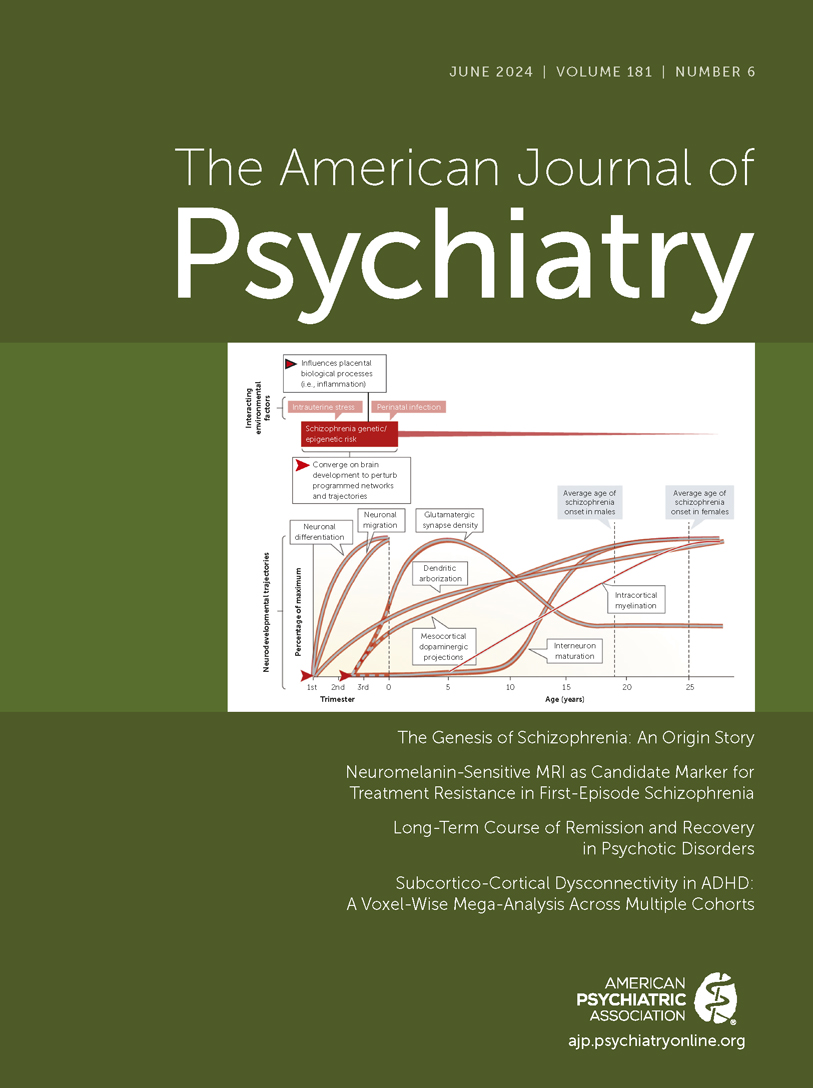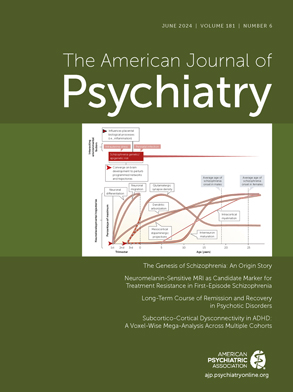We know a lot about the overlap between attention deficit hyperactivity disorder (ADHD) and autism spectrum disorder (ASD). The conditions co-occur frequently, they share some cognitive features, and they have a marked overlap in underlying genetic and environmental influences (
1). Perhaps surprisingly, we know much less about the overlap in brain function, particularly when the brain is actively engaged in psychological processes. This knowledge gap is partly addressed by a meticulously conducted and conceptually elegant meta-analysis of brain function in ADHD and ASD by Tamon et al. in this issue of the
Journal (
2). By quantitively combining published results from 243 neuroimaging studies, the authors conclude that diagnostic differences in brain function greatly exceed similarities. Their findings suggest that we should split ADHD from ASD rather than lumping these neurodevelopmental conditions together.
Why has our understanding of the shared and distinct features of brain function in ADHD and ASD lagged behind other fields, such as the genomics of ADHD and ASD? Partly it stems from the different tasks that have been used to probe the neural correlates of the different conditions. Unsurprisingly, in the study of ADHD, functional MRI (fMRI) tasks of working memory, response inhibition, and reward processing have dominated, commensurate with their role in ADHD, whereas in ASD, the focus has been on social understanding and communication. Fortunately, there has been some overlap in cognitive tasks assessed in participants with each disorder; this overlap grows when tasks are grouped into higher-order psychological constructs. In this meta-analysis, the authors cleverly leveraged this overlap. They selected equal numbers of tasks in seven different psychological domains that included attention, working memory, and social processes. For example, if performance in two tasks involving social processes were evaluated in the ADHD-related studies, then two tasks would be selected at random from the larger pool of social processing tasks found in studies focused on ASD. This selection process was repeated many times. Having such balanced samples of individuals with ASD or with ADHD performing overlapping tasks allowed the authors to compare “apples to apples,” which is critical when looking across diagnoses. Next, they used published data to map the brain regions where individuals with ADHD consistently showed greater or lesser activation across all psychological domains compared with typically developing individuals. The authors then repeated this mapping for individuals with ASD. By overlaying the two maps, the differences and similarities of the “brain in action” in ADHD and ASD emerged.
The findings are intriguing. Most strikingly, diagnosis-specific differences in functional architecture dominate, and these differences often align with current conceptual models. For example, in ADHD, but not in ASD, there is less activation relative to typically developing individuals in frontocortical (e.g., the inferior frontal gyrus) and striatal (e.g., the globus pallidus) regions. Changes in such corticostriatal circuits have long been thought to underpin cognitive features seen in ADHD, particularly differences in working memory and response inhibition (
3). In ASD, the authors highlighted a mix of greater and less activation in regions adjacent to the anterior cingulate cortex, a region that has been implicated in ASD by others.
Findings of shared brain function in ASD and ADHD were less prominent in this meta-analysis. Both diagnoses showed less activation than that observed in neurotypical groups in limited regions of the right frontotemporal cortex, consistent with some models of these conditions (
4). Both ADHD and ASD groups showed greater activation in the right rectus and right lingual gyri, which is perhaps harder to interpret. Dysfunction within visual cortical regions such as the lingual gyrus is not central to models of neurodevelopmental conditions, particularly ADHD. However, such unexpected results perhaps illustrate one of the strengths of using meta-analyses: they can alert us to findings that may have been hiding in plain view.
Just as the study exemplifies some strengths of meta-analysis, it has its limitations, many of which were acknowledged by the authors. For example, the estimates of the differences of both the ADHD and ASD groups from typically developing groups were likely inflated, because the meta-analysis was based on published results, which are often biased in favor of significant differences (
5). This bias may have been compounded by an analytic approach that excluded studies that did not report brain regions with diagnostic differences. It would be interesting to know how robust the findings are when incorporating unpublished or excluded task data that may have differed systematically from the data that were included.
A meta-analysis is only as good as its constituent data, and in this regard, several points can be made. First, some of the psychological domains were evaluated in only a few studies. For example, although social processes have been richly explored in ASD, there are only a handful of studies evaluating social processes in ADHD, and the final number of fMRI tasks used in the analysis was determined by the lower number seen in ADHD studies (in order to attain a balanced comparison). The small number of tasks in such domains resulted in relatively few subjects in the meta-analysis, and thus the examination of that domain may have been underpowered. Other domains that were included, such as attention, showed higher, more balanced numbers of studies in both ADHD and ASD. Thus, domains such as attention likely had an outsized influence on the measure of brain function across all psychological domains, which was the primary focus of the meta-analysis. In short, the strategy used by the authors circumvents many but probably not all of the imbalances in task-based imaging of ADHD and ASD.
The meta-analysis rests upon the validity of assigning every fMRI task to higher-order psychological domains. To boost such validity, a robust taxonomy of psychological domains was used (the NIMH Research Domain Criteria), and the allocation was made by two independent raters. However, the fundamental unit in the meta-analysis is ultimately a contrast between fMRI brain activity during performance of one task compared with activity during performance of another active task or a control task or during a baseline condition. Each contrast may tap a different psychological process even when all the contrasts are collected within one experiment. Furthermore, different task contrasts will likely map to the higher-order psychological domains with different degrees of fidelity. The allocation of an fMRI task contrast to a domain is not straightforward, and misallocation could be problematic, particularly for domains containing few experiments.
It is worthwhile to situate this meta-analysis within the rapidly advancing field of large-scale neuroimaging studies and to consider how it informs future research priorities. This meta-analysis of task-based fMRI studies complements meta-analyses of resting-state fMRI studies, in which scans are acquired while participants are free of any explicit task demands. In resting-state fMRI, some patterns of synchronized activity emerge that resemble the brain networks seen during task-based fMRI. Resting-state fMRI has become popular for meta-analyses because these data are easier to harmonize across studies and are more routinely collected across different diagnoses. For these reasons, resting-state fMRI has the advantage of sample sizes that exceed even the impressive numbers of this task-based meta-analysis. Meta-analyses of resting-state fMRI data have focused on ADHD and ASD separately (
6,
7), and when the findings of these resting-state fMRI meta-analyses are placed side by side, disorder-specific features exceed shared features. Thus, both resting-state and task-based fMRI give similar initial answers.
Whereas Tamon and colleagues used published summary data, another research strand uses individual-level neuroimaging data (
8). This is possible because of multiple, large, shared cohorts, such as the Adolescent Brain Cognitive Development Study and the Healthy Brain Network. Individual-level data from all cohorts can be entered into one model that uses statistical techniques to account for possible clustering of data acquired at different sites. This approach, called mega-analysis, thus differs from meta-analysis, which integrates the summary findings of different cohorts. There are several advantages to using individual-level neuroimaging data. First, activation across the entire brain can be examined, rather than having the analysis constrained to the published coordinates of group differences. Such whole-brain meta-analyses can capture diagnostic differences that may be just below the threshold for significance in an individual study but are nonetheless present across several studies. Second, some important sources of heterogeneity in traditional meta-analyses can be removed. For example, differences in how imaging data are processed at different study sites can be removed by processing all the individual, raw imaging data from scratch in a uniform manner. Finally, the use of individual-level data allows a precise one-to-one matching of individuals with a diagnosis to neurotypical control participants on demographic, cognitive, and technical features, such as degree of head motion in the scanner. Meta- and mega-analyses conducted on such closely matched data will avoid many confounders known to affect neuroimaging studies. Relatedly, key individual-level features, such as medication history and the presence of co-occurring mood or anxiety symptoms, can be examined in a robust manner that is impossible when using published, summary-level data.
Looking to the future, it is notable how the meta-analysis by Tamon et al. informs research priorities. As the authors stress, there are only a handful of fMRI studies that include individuals with ADHD and individuals with ASD performing the same task. Although these head-to-head-studies have also found that diagnostic differences exceed similarities, the brain regions identified did not overlap with those emerging from the meta-analysis. To resolve this discrepancy, we need more fMRI studies where individuals with ADHD, ASD, or both diagnoses perform the same task.
Tamon et al. found largely distinct neural landscapes in ADHD and ASD, suggesting we should split apart rather than lump together these conditions. A third option is to collect more data. Specifically, by collecting data from a common core set of tasks transdiagnostically, we could obtain the large data sets needed to capture fully the brain’s functional architecture in these complex neurodevelopmental conditions.

